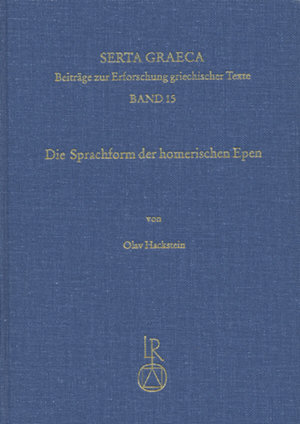
Die Sprachform der homerischen Epen
Faktoren morphologischer Variabilität in literarischen Frühformen: Traditionen, Sprachwandel, sprachliche Anachronismen
von Olav Hackstein
In der Forschung besteht heute Einigkeit darüber, dass die Sprache von Ilias und Odyssee in der Tradition einer jahrhundertealten, mündlich tradierten Formelsprache steht. Die vorliegende Arbeit untersucht die Frage, inwieweit die homerische Sprache ausschließlich eine „tote Sprache” ist und wie groß der sprachliche Spielraum gewesen sein mag, neben der tradierten archaischen Formelsprache auch Elemente des „lebendigen” Altionischen des 8. Jh. v. Chr. einfließen zu lassen. Es wird die These verfochten, dass der Spielraum für „sprachliche Originalität” weitaus mehr genutzt wurde als bisher angenommen und dass das Dichteridiom von Ilias und Odyssee der altionischen Alltagssprache des 8. Jahrhunderts v. Chr. ebenfalls sehr viel näher stand als bisher vermutet. Eine systematische Untersuchung der homerischen Verbalmorphologie fördert durchweg auch sprachlich jüngere Formen zutage, die scheinbar anachronistisch entweder erst später etablierte morphologische Ausgleichsprozesse vorwegzunehmen scheinen (antizipatorische Anachronismen) oder hierin der späteren Sprache der klassischen Epoche sogar noch vorauseilen (isolative Anachronismen). Das Paradoxon sprachlich jüngerer Formen in sprachlich älteren Sprachepochen löst sich indessen, wenn man mit verschiedenen synchronen Sprachschichten rechnet, mindestens mit einer neben der konservierenden Formelsprache stehenden kontemporären Alltagssprache. Dafür dass alltagssprachliche Formelemente an sprachlichen Ausgleichserscheinungen teilnehmen, die sich entweder erst später oder auch nie durchsetzen, d.h. späterer Normierung zum Opfer fallen, gibt es in der Sprachgeschichte anderer europäischer Sprachen viele Beispiele.
Eingeordnet in den beschriebenen Erklärungszusammenhang können viele Rätsel der sprachwissenschaftlichen Homererklärung einer Lösung zugeführt werden. Viele Formen, deren Echtheit bisher in Zweifel gezogen wurde, sind jetzt von sprachwissenschaftlicher Seite nicht mehr zu beanstanden.
Nicht allein die Textkritik profitiert dabei von den Ergebnissen der Untersuchung, sondern auch einige in der Indogermanistik vieldiskutierte Formen können einer neuen ausgewogenen Deutung zugeführt werden. Von Bedeutung für die griechische Sprachwissenschaft sind ferner systemhafte Neuerungen im frühgriechischen Verbalsystem, die bisher nicht als solche erkannt worden sind. So kann die Arbeit insgesamt als Supplement zum Verbalteil von Pierre Chantraines Grammaire homérique gelten (Tome I: Phonétique et morphologie. 5., korr. Auflage. Paris 1973).
One of the most salient characteristics of the Homeric language is its morphological variability. Ever since Witte and Parry, the meter and the formulaic diction have been believed to be the major factors conditioning the linguistic diversity of Homer’s epics.
While it has always been uncontroversial that the meter and the formulaic diction have a double-effect entailing both the preservation of linguistic archaisms and necessitating at the same time linguistic innovation with the employment of artificial and vernacular forms, it has rarely been asked let alone investigated whether additional factors can be held responsible for the linguistic diversity of Early Epic Greek. Prose texts in other languages and cultures may show an amount of morphological diversity comparable to that of Homer’s epics and suggest that other factors than meter and formulaic diction may be at work generating a linguistic picture comparable to that offered by the Ilias and the Odyssey. Meter and formulaic diction need not be the only factors creating the surface symptom of morphological variability. Other factors include intra-linguistic processes (ongoing language change) and extra-linguistic stimuli (medial change). Most important among these is the beginning of literacy which always is characterized by a relative absence of language norms thus leaving more leeway for a freer combination of traditional (orally transmitted) language and contemporaneous vernacular language. The assumption that the poet(s) of the Homeric epics drew on the Ionic vernacular language is not entirely new; it has been hypothesized already by Witte and Parry. However none of these nor anybody else has attempted to identify the alleged traits of Ionic vernacular language in Homer’s epics.
Progress is however possible in light of new heuristic methods. As can be exemplified by many languages, vernacular forms frequently appear in the guise of “anachronisms”, either as anticipatory anachronisms appearing later on in Ionic or as isolated (abortive) anachronisms passing from living use afterwards. The
notion of the linguistic anachronism plays a central role in determining the vernacular Ionic variety of Greek posited by Parry. While such anachronistically “young” forms at first sight always seemed paradoxical and were athetized or emended in the course of textual edition, the paradox turns out to be a pseudo-paradox, once one realizes that the impression of an anachronism is created by the interweaving of two different but nonetheless synchronic varieties of Greek. Much of the seemingly anomalous forms can be real in Old Ionic and conform to well attested tendencies of the morphological development of Greek (remodelling of the ablaut system, thematization of athematic stems).
In summary, the present work investigates the potential of the Homeric language to preserve archaisms and to exhibit linguistic innovation at the same time. It contains a new assessment of many difficult Homeric verb forms and thus purports to be a supplement to the treatment of the early epic Greek verb in Pierre
Chantraine’s Grammaire homérique (Tome I: Phonétique et morphologie. 5th corr. edition. Paris 1973). More generally, the monograph contains a typology of the interrelationship of social change and language change.






